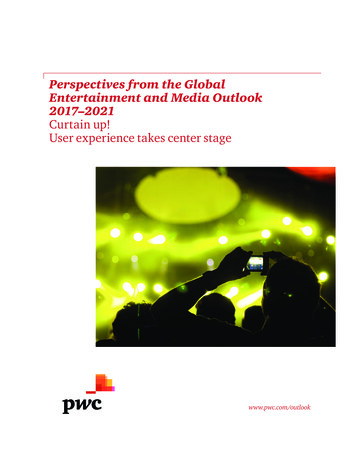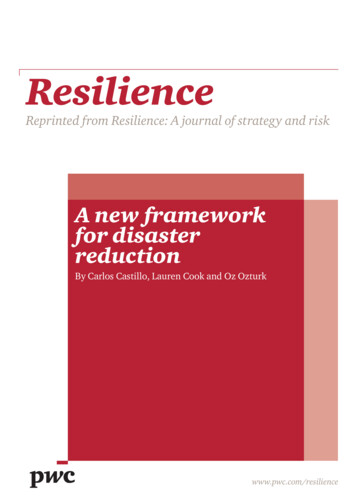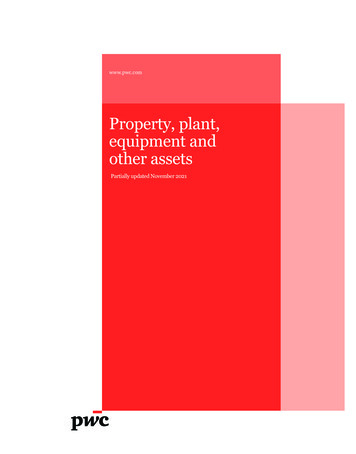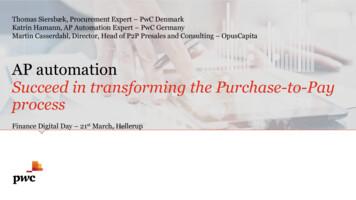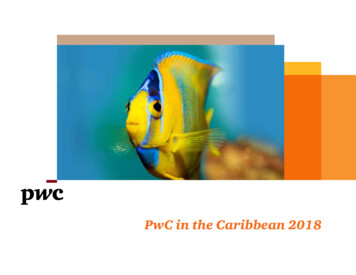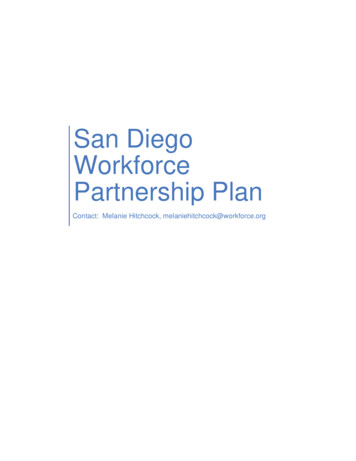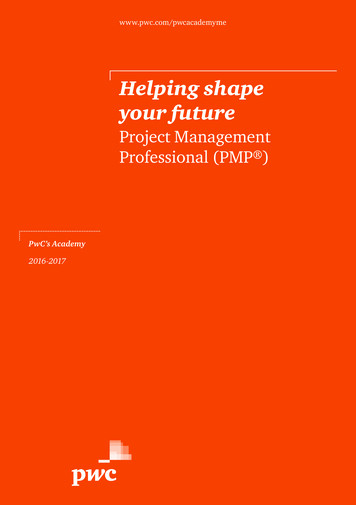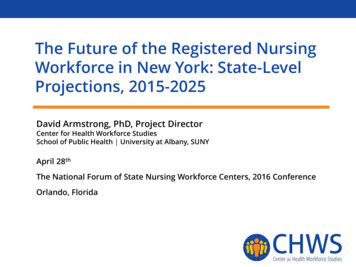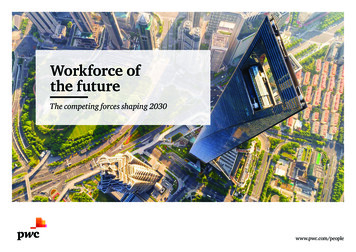
Transcription
Workforce ofthe futureThe competing forces shaping 2030www.pwc.com/people
Workforce of the future: The competing forces shaping 2030ContentsThe messages for leaders5The forces shaping the future6How digital and artificial intelligence are changing work8The Four Worlds of Work in 203010Red World12Blue World16Green World20Yellow World24What does this mean for jobs?30Working together as a society – our recommendations32The individual response34‘No regrets’ moves for organisations36Conclusion38Appendix39PwC’s global People and Organisation practice brings together anunmatched combination of 10,000 people with industry, business, talent,strategy, HR, analytics and technology expertise in one team across138 countries.Together, we build tailored people and organisation solutions with a deepunderstanding of our clients’ uniqueness, grounded in rigorous analysisand data‑driven insight, to create lasting, differentiated value.We help clients to implement organisational transformation, improve theeffectiveness of their workforce, develop and move talent around theirbusiness, and manage their human capital risks. We work from peoplestrategy through to organisational execution.2
ForewordWe are living through a fundamental transformation in the way we work. Automation and‘thinking machines’ are replacing human tasks and jobs, and changing the skills that organisationsare looking for in their people. These momentous changes raise huge organisational, talent andHR challenges – at a time when business leaders are already wrestling with unprecedented risks,disruption and political and societal upheaval.The pace of change is accelerating. Competition for theright talent is fierce. And ‘talent’ no longer means the sameas ten years ago; many of the roles, skills and job titles oftomorrow are unknown to us today. How can organisationsprepare for a future that few of us can define? How willyour talent needs change? How can you attract, keep andmotivate the people you need? And what does all this meanfor HR?This isn’t a time to sit back and wait for events to unfold.To be prepared for the future you have to understand it.In this report we look in detail at how the workplace mightbe shaped over the coming decade.Our report draws on research begun in 2007 by a teamfrom PwC and the James Martin Institute for Science andCivilisation at the Said Business School in Oxford and aspecially commissioned survey of 10,000 people in China,India, Germany, the UK and the US. This has given usinsights into how people think the workplace will evolveand how this will affect their employment prospects andfuture working lives. Our thanks to all those who kindlyshared their perspectives.No exploration of the future of work will ever be conclusive.Indeed, one of the defining characteristics of our age isits ability to surprise and confound. This report develops‘Four Worlds of Work’ for 2030 which will kickstartyour thinking about the many possible scenarios thatcould develop, and how to best prepare for the future.Remember that your starting point matters as much as yourdestination; the best response may mean radical change,or perhaps just a few steps from where you are today. Yourresulting strategy will inevitably mean a combination ofobvious, ‘no regrets’ actions and the occasional, educatedleap of faith.Carol StubbingsGlobal Leader, People and Organisation, PwC3
Workforce of the future: The competing forces shaping 2030“So what should we tell our children? That tostay ahead, you need to focus on your ability tocontinuously adapt, engage with others in thatprocess, and most importantly retain your core senseof identity and values. For students, it’s not just aboutacquiring knowledge, but about how to learn. Forthe rest of us, we should remember that intellectualcomplacency is not our friend and that learning –not just new things but new ways of thinking – is alife-long endeavour.”Blair SheppardGlobal Leader, Strategy and LeadershipDevelopment, PwC“I’m not worried, as anautomated workplacewill also need humanskills.”Male full-time student (18),India4
The messages for leadersAct now.People not jobs.This isn’t about some ‘far future’ of work – change isalready happening, and accelerating.Organisations can’t protect jobs which are made redundantby technology – but they do have a responsibility totheir people. Protect people not jobs. Nurture agility,adaptability and re-skilling.No regrets and bets.The future isn’t a fixed destination. Plan for a dynamicrather than a static future. You’ll need to recognisemultiple and evolving scenarios. Make ‘no regrets’ movesthat work with most scenarios – but you’ll need to makesome ‘bets’ too.Make a bigger leap.Build a clear narrative.A third of workers are anxious about the future and theirjob due to automation – an anxiety that kills confidenceand the willingness to innovate. How your employees feelaffects the business today – so start a mature conversationabout the future.Don’t be constrained by your starting point. You might needa more radical change than just a small step away fromwhere you are today.Own the automation debate.Automation and Artificial Intelligence (AI) will affect everylevel of the business and its people. It’s too important anissue to leave to IT (or HR) alone. A depth of understandingand keen insight into the changing technology landscape isa must.5
Workforce of the future: The competing forces shaping 2030The forces shaping the futureThe future of work asks us to consider the biggest questionsof our age. What influence will the continuing march oftechnology, automation and artificial intelligence (AI) haveon where we work and how we work? Will we need to workat all? What is our place in an automated world?Many commentators focus on technology and the role thatautomation is predicted to have on jobs and the workplace.We believe the real story is far more complicated. This is lessabout technological innovation and more about the mannerin which humans decide to use that technology.The shape that the workforce of the future takes will be theresult of complex, changing and competing forces. Someof these forces are certain, but the speed at which theyunfold can be hard to predict. Regulations and laws, thegovernments that impose them, broad trends in consumer,citizen and worker sentiment will all influence the transitiontoward an automated workplace. The outcome of this battlewill determine the future of work in 2030.MegatrendsThe megatrends are the tremendous forces reshapingsociety and with it, the world of work: the economic shiftsthat are redistributing power, wealth, competition andopportunity around the globe; the disruptive innovations,radical thinking, new business models and resource scarcitythat are impacting every sector. Businesses need a clearand meaningful purpose and mandate to attract and retainemployees, customers and partners in the decade ahead.The megatrends identified by PwC form the foundation forall our scenarios. How humans respond to the challengesand opportunities which the megatrends bring willdetermine the worlds in which the future of work plays out.When so many complex forces are at play, linear predictionsare too simplistic. Businesses, governments and individualsneed to be prepared for a number of possible, even seeminglyunlikely, outcomes.1006Figure 1: When you think about the future world of work asit is likely to affect you, how do you feel?37%36%18%8%Excited – I see a world full of possibilityConfident – I know that I will be successfulWorried – I’m nervous about what the future holdsUninterested – I tend not to think too far aheadPwC survey of 10,029 members of the general population based in China,Germany, India, the UK and the US – base all those who are not retired 8,459
changeourceTechnological breakthroughsDemographic shiftsRapid urbanisationRapid advances intechnological innovationThe changing size, distributionand age profile of theworld’s populationSignificant increase in theworld’s population moving tolive in citiesAutomation, robotics and AI areadvancing quickly, dramaticallychanging the nature and numberof jobs available. Technologyhas the power to improve ourlives,raising productivity, livingTechnologicalstandardsand average lifebreakthroughsspan, and free people to focuson personal fulfilment. But italso brings the threat of socialunrest and political upheavalif economic advantages are notshared equitably.With a few regional exceptionsthe world’s population is ageing,putting pressure on business,social institutions and economies.Our longer life spanwill mographicShiftin cialsocialeconomiceconomicandsocialeconomicand pension costs. powerOlderchangechangepowerworkerschangepowerwill need to learn new skills andwork for longer. ‘Re-tooling’ willbecome the norm. The shortage ofa human workforce in a numberof rapidly-ageing economies willdrive the need for automation andproductivity enhancements.Shifts in globaleconomic powerResource scarcity andclimate changePower shiftingbetween developed anddeveloping countriesDepleted fossil fuels, extremeweather, rising sea levels andwater shortagesBy 2030, the UN projects that4.9 billion people will be urbanThe rapidly developing nations,dwellers and, by 2050, theparticularly those with a largeworld’s urban population willworking-age population, thathaveincreased byDemographicsome72%1change.embracea businessRapidethos, RapidClimatechange andandsocialresourceresource economicbreakthroughsbreakthroughs ionandresourcebreakthroughshave GDPs larger tyscarcitypowerchangepowerscarcitycountries. In this new world, cities most. Emerging nations face thewill become important agents forbiggest challenge as technologyjob creation.increases the gulf with thedeveloped world; unemploymentand migration will continue tobe rampant without significant,sustained investment. The erosionof the middle class, wealthdisparity and job losses dueto large-scale automation willincrease the risk of social unrest indeveloped countries.Demand for energy and water isforecast to increase by as muchas 50% and 40% respectivelyby20302. changeNew types ceresourcebreakthroughsengineeringprocesses, productscarcityscarcitydesign and waste managementand re-use will need to becreated to deal with these needs.Traditional energy industries,and the millions of peopleemployed by them, will see arapid restructuring.Find out more about PwC’s Global Megatrends http://www.pwc.co.uk/megatrends1 UN Department of Economic and Social Affairs. ublications/pdf/urbanization/WUP2011 Report.pdf2 National Intelligence Council. https://www.dni.gov/files/documents/GlobalTrends 2030.pdf7
Workforce of the future: The competing forces shaping 2030How digital and artificial intelligenceare changing workThe potential for digital platforms and AI to underpin andgrow the world of work is unbounded. They already playan essential role in the development of all Four Worlds ofWork, matching skills to employer, capital to investor andconsumer to supplier.This platform layer brings a digital value chain andcommoditisation and automation of the back office –but comes with warnings. While it can create a thrivingmarketplace, it can grow to take over the entire economicsystem. And with platform pervasiveness comesvulnerability to cyber-attacks or wide-scale manipulation.Closely linked to digital is data. How governments,organisations and individuals decide to share and use itis key to all our worlds – even the most human-centric.Finally AI: the digital assistants, chatbots, and machinelearning, that understand, learn, and then act based on thatinformation3. It’s useful to think of three levels of AI:Assisted intelligence, widely available today, improveswhat people and organisations are already doing. A simpleexample, prevalent in cars today, is the GPS navigationprogramme that offers directions to drivers and adjusts toroad conditions.Augmented intelligence, emerging today, helps peopleand organisations to do things they couldn’t otherwise do.For example, car ride-sharing businesses couldn’t existwithout the combination of programmes that organisethe service.Autonomous intelligence, being developed for the future,establishes machines that act on their own. An exampleof this will be self-driving vehicles, when they come intowidespread use.Some optimists believe AI could create a world wherehuman abilities are amplified as machines help mankindprocess, analyse, and evaluate the abundance of datathat creates today’s world, allowing humans to spendmore time engaged in high-level thinking, creativity,and decision-making.3 For more on AI and how it’s changing work, see our 2017 report:Bot.Me: A revolutionary partnership http://www.pwc.com/CISAI873%think technologycan never replace thehuman mind.37%are worried aboutautomation putting jobsat risk – up from 33%in 2014.PwC survey of 10,029 membersof the general population based inChina, Germany, India, the UK andthe US
“Automation, machinesare replacing so manyjobs. Many people thinkthat only the poor anduneducated are beingdisplaced. I’m afraid thatin a few years everyonewill be replaceable.”Retired female withpostgraduate degree (67),USAAutonomous IntelligenceFutureAugmented IntelligenceAssisted IntelligenceEmergingTodayAutomating repetitive,standardised ortime-consumingtasks and providingassisted intelligence.Increased demand forSTEM skills to buildnew tech ecosystem.Adaptive continuousintelligent systems takeover decision-making.The future of humans atwork is questioned.Fundamental changein the nature ofwork. Humans andmachines collaborate tomake decisions.Uniquely human traits –emotional intelligence,creativity, persuasion,innovation – becomemore valuable.9
Workforce of the future: The competing forces shaping 2030Shaping our own destinyMegatrends provide the context for future worlds butthey don’t dictate their shape or features at a specificpoint in time. How humans respond to the challenges andopportunities which the megatrends bring will determinethe worlds in which the future of work plays out.Public sentiment, and its impact, is difficult to predict,affected by culture, history and many other local factors.As we’ve seen in recent years, public sentiment canradically affect the approach of a nation in the space of asingle election or referendum. But there’s no doubt thatgovernments and public sentiment will influence theforces underpinning each scenario. For this reason, weadded some distinctly human dynamics into our scenarioanalysis: the ‘push and pull’ effect of collectivism versusindividualism, and integration versus fragmentation.Collectivism versus individualismIntegration versus fragmentationWill ‘me first’ prevail, or will societies work togetherthrough a sense of collective responsibility? What is therole of government in balancing a strong economy with theinterests of its people? Regions and countries – and evencities – will inevitably take a different view on the level ofstate intervention needed.Will digital technology inevitably mark the end for largecompanies? Technology has allowed tiny businesses to tapinto a vast reservoir of information, skills and financingthat used to be available only to large organisations.Through the use of technology, small has become powerful.It’s also allowed large companies to drastically reducetheir internal and external costs. Organisations can bemore productive with fewer staff and can expand theiroperations (through contingent workers, for example)without having to invest significant amounts of capital.But once again, human agency plays its part.Government actions can incentivise or penalise largerbusinesses, or encourage small business and start-ups.Business fragmentation:Small is powerful.Large businesses lose their dominance as customers seek relevanceand organisations find scale a burden rather than a benefit. Socialbubbles and affinity groups take on a new importance. Many could notexist without digital platforms.Individualism:Collectivism:Where ‘me first’ rules.Fairness and equality dominates.A focus on individual wants; a response to the infinitechoices available to consumers.The common good prevails over personal preference,e.g. collective responsibility for the environment,social good and ‘fairness’ over individual interest.Corporate integration:Big business rules all.Companies get bigger and more influential – the biggest have moresway than some nations. Brands span many business areas.10
The Four Worlds of Work in 2030FragmentationThe Yellow WorldHumans come firstSocial-first and community businesses prosper. Crowdfunded capital flowstowards ethical and blameless brands. There is a search for meaning andrelevance with a social heart. Artisans, makers and ‘new Worker Guilds’ thrive.Humanness is highly valued.The Red WorldInnovation rulesOrganisations and individuals race to give consumers what they want.Innovation outpaces regulation. Digital platforms give outsized reachand influence to those with a winning idea. Specialists and niche profitmakers flourish.CollectivismThe Green WorldCompanies careIndividualismThe Blue WorldCorporate is kingSocial responsibility and trust dominate the corporate agenda with concernsBig company capitalism rules as organisations continue to grow bigger andabout demographic changes, climate and sustainability becoming key driversindividual preferences trump beliefs about social responsibility.of business.Integration11
Workforce of the future: The competing forces shaping 2030Innovation rules: The Red WorldIn a world with few rules, a vibrant market of specialists and niche profit-makers race to serve theneeds of individuals and powerful affinity groups.Red World: The road to 20302020High-profile personalscandals and corruptionby politicians and businessleaders in a number ofnations are unresolved,signalling to the world that‘anything goes’ and creatinga push back on turn-of-themillennium standards.122021A lifestyle app developed bysix Taiwanese 17-year-oldsfor their final-year exams issold for 49m in a worldwideonline auction organised bythe students’ school.202220252030UK Court of Appeal rulesthat ideas developed outsidebusiness hours by colleaguesof the same company remainits intellectual property,even if the workers are notpermanent employees.A decade of demergers and‘carve outs’ across industrysectors peaks.The number of US workersin full-time ‘permanent’employment drops to9% of the workforce,an all-time low.
60%think ‘few people willhave stable, long-termemployment in thefuture’.PwC survey of 10,029 membersof the general population based inChina, Germany, India, the UK andthe USA world of innovation with few rulesAgility and speed are essentialWhat it means for workersThe Red World is a perfect incubatorfor innovation.Big business has been outflanked in a digitalenabled world that’s teeming with smallentrepreneurial companies.Specialism is highly prized in the Red Worldand a career, rather than being defined by anemployer or institution, is built from individualblocks of skills, experience and networks.New products and business models develop atlightning speed, far more quickly than regulatorscan control. Technology encourages thecreation of powerful, like-minded, cross-bordersocial ‘bubbles’. Businesses innovate to createpersonalisation and find new ways to servethese niches.Digital platforms match worker with employer,skills with demand, capital with innovator,and consumer with supplier. This allows serialentrepreneurs to reach far beyond their size interms of influence and scale.There are high rewards on offer for those ideasand skills that best meet what companies andconsumers want. But in a world with few rules,the risks are high. Today’s winning businesscould be tomorrow’s court case.Anxious to compete, larger employers fragment tocreate their own internal markets and networks tocut through old-style hierarchies and encourageand reward workers to come up with new ideas.The pace of development and testing of newproducts and services has accelerated, increasingthe risk of brand damage and failure.Near-zero employee organisations are thenorm. Organisations of a few pivotal people usetechnology, the supply chain and intellectualproperty, rather than human effort and physicalassets, to generate value.The commercial value of learning takesprecedence; a university degree is seen asless valuable than specific and relevant skillsor experience.Workers know that the most sought-afterskills will mean the biggest reward package.Many move frequently and stay only as longas the project or business lasts. Contractnegotiations are key and ownership ofintellectual property and the freedom to workare as important as financial incentives.13
Workforce of the future: The competing forces shaping 2030Who leads on people strategy?What does the workforce look like?Organisational challenges Innovation and people are inseparable in theRed World. Specialism is highly prized and workers seekto develop the most sought-after skills tocommand the biggest reward package. Speed to market is everything in the RedWorld – any decision-making process orhierarchy that delays innovation is a barrierto success. HR does not exist as a separate function andentrepreneurial leaders rely on outsourced Organisations are typically stripped-down andservices and automation for people processes.nimble, supplemented by talent attracted by the While ideas flourish, organisations compete tonext promising opportunity.‘own’ them. Larger organisations scour the world to‘acqui-hire’ talent and intellectual property A small number of ‘pivotal people’ with Innovation creates a high-risk environment;outstanding management skills commandusing specialist talent strategists in combinationregulation struggles to catch up – but when ithigh rewards.with AI to identify the specialists they want.does, it impacts unevenly and suddenly. Digital platforms match worker with employer Like-minded workers gravitate towards each Workforces are lean but there’s still intenseand skills with demand.competition for critical skills.other, aided by technology, sparking bubblesof innovation. Performance is all about the end result ratherthan the process – ‘old-fashioned’ performance Projects quickly flourish, evolve and resolve andspecialists move rapidly from one to the next.measurement and analysis is rare.14“There’s a lack of loyaltyfrom the companytowards the employees.Workers with skills indemand will prosper,those with outdated skillswill be abandoned.”Part-time Governmentemployee (66), USA
ure viewFutSkillScanExTMAnticipating your talent needsI want toRed WorldIn 2030, the searchfor talent is as difficultas ever. Artificialintelligence allowsbusinesses to identifythe talent they need,when they need it.Here’s an extract froman AI-powered talenttool which mightbe readily availablein 2030.SkillScanExTM AggregatorFind the talent you need, no matter whichplatform it’s on. Our natural language interfaceallows you to tell us what you need – and whatyou don’t.SkillScanExTM AnticipatorConnect at a deeper level and Anticipator willalert you when you need new skills or capacityfrom the conversations happening within yourbusiness. Anticipator helps you make the rightchoice between human and machine talent.View allSkillScanExTM Business plannerBusiness Planner links customer enquiries, openinnovation projects and current human andautomated productivity to forecast both businessperformance and critical skills gaps.Load more15
Workforce of the future: The competing forces shaping 2030Corporate is king: The Blue WorldGlobal corporates take centre stage. Consumer choice dominates. A corporate career separates thehaves from the have nots.Blue World: The road to 20302020The net worth of the top1% of Chinese householdsovertakes that of the top1% of US households for thefirst time.162021Merger of the world’s biggestsocial media site andAfrica’s largest telecomscompany becomes the biggestcorporate deal ever recorded.202220252030The world’s biggest employeragrees unique ‘borderless’working for its employeesacross its six biggest marketsin a ground-breaking taxdeal with their governments.UN agrees its Ethical Charteron Human Enhancement.India’s largest tech companyannounces a 24% increasein annual revenue, largelyattributed to its introductionof cognitive-enhancing drugsfor its workforce.
Capitalism reigns supremeExtreme talentWhat it means for workersIn the Blue World, companies see their size andinfluence as the best way to protect their prizedprofit margins against intense competition fromtheir peers and aggressive new market entrants.Corporations grow to such a scale, and exertsuch influence, that some become more powerfulthan nation states.Corporates may dominate the Blue World,but workforces are lean.For workers in the Blue World, the pressure toperform is relentless. Those with a permanentrole enjoy excellent rewards, as do in-demandcontract workers with specialist skills – but bothknow that their future employability depends onkeeping their leading-edge skills relevant.Success depends on a productive workforce aslarge companies compete for the best talent.They push past the limits of human ability byinvesting augmentation technology, medicationand implants to give their people the edge.Exceptional talent is in high demand –employers secure a core group of pivotalhigh-performers by offering excellent rewardsbut otherwise buy in flexible talent and skillsas and when they’re needed.Human effort, automation, analytics andinnovation combine to push performancein the workplace to its limits; human effortis maximised through sophisticated use ofphysical and medical enhancement techniquesand equipment, and workers’ performanceand wellbeing are measured, monitored andanalysed at every step. A new breed of elitesuper-workers emerges.A corporate employer separates the haves fromthe have nots; companies provide many of theservices, from children’s education, eldercareand healthcare, previously provided by the state.The price workers must pay is their data.Companies monitor and measure obsessively,from the location of their workforce to theirperformance, health and wellbeing – both in andoutside the workplace. Organisations use thedata to predict performance and importantly,to anticipate people risk.70%would consider usingtreatments to enhancetheir brain and bodyif this improvedemployment prospectsin the future.PwC survey of 10,029 membersof the general population based inChina, Germany, India, the UK andthe US – base all those who are notretired 8,45917
Workforce of the future: The competing forces shaping 2030Who leads on people strategy?What does the workforce look like? The Chief People Officer (CPO) is a powerful and influential figure, sometimes known as the‘Head of People and Productivity’, and who sitson the board. The science of human capital has developedto such a degree that the connection betweenpeople and performance is explicitlydemonstrated by the CPO. The people risk agenda is one which is takenseriously by the board – as a result, the CPOand HR become more influential.Aside from a core group of high-performers, The challenges of size and scale mean thatorganisations are at greater risk from externaltalent is bought in where and when it’s needed.threats such as technology terrorism or‘Retainer and call-up’ contracts are frequentlymeltdown and they find it difficult to effectused for rare skills.change quickly. Top talent is fiercely fought over – the bestengage an agent to negotiate and manage The value of human capital at the top leveltheir career.is high and the upward pressure on reward,particularly for senior executives, is intense. Employers begin their search for exceptionaltalent early, forming links with schools and Organisations must develop models andengaging promising youngsters.systems which enable individuals andtheir agents to negotiate the value of theirhuman capital based on employees’ personal Employees of all levels take an active role ininvestment strategies.their own career development, honing theirskills whenever they can and however they can– including human enhancements. Society divides into those with a corporatecareer – and those who don’t have access tothe same level of financial rewards, healthcareand benefits.18Organisational challenges“The gap between therich and the poor. Eitherpeople will have a highpaying job or no jobat all.”Unemployed female (50),Germany
ure viewFutWorld News3 May 2030 09.30 ETBlue WorldIn 2030, organisationsbegin to realise thebenefits of humanenhancement inthe workplace.An online news reportfrom 2030 details thefirst large-scale use ofcognitive-enhancingdrugs.Drumhum Inc leads the pack in the use of cognitive-enhancing drugs in the workplace ascompanies begin to realise their benefits.Drumhum Inc, the first large employer tooffer cognitive-enhancing medication to itsemployees, says it has seen a 4% increase inproductivity during the first three months ofthe financial year.Drumhum offered the methylpehnidate-baseddrug Cognitalin, the first cognitive enhancerto be mass produced specifically for use in theworkplace, to its employees on a voluntarybasis at the beginning of the year. “Theprogramme,” said Nancy Cole, the company’sHead of People Performance, “was closelymonitored; it was also heavily oversubscribed,with more than 73% of Drumhum
New types of jobs in alternative energy, new engineering processes, product design and waste management and rese will need to be ‑u created to deal with these needs. Traditional energy industries, and the millions of


